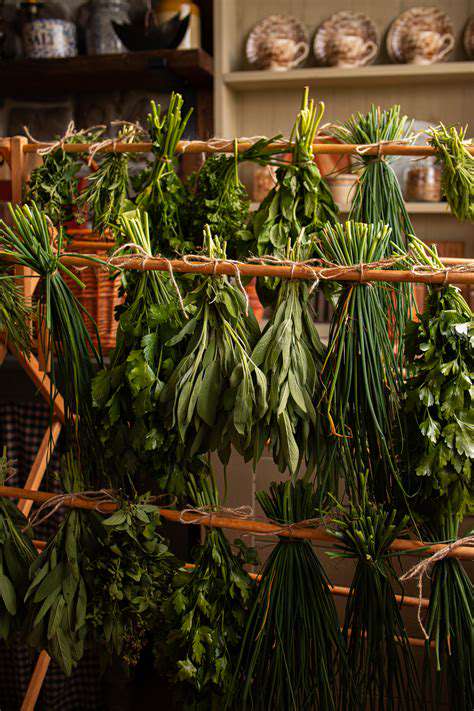Cooking with Lentils: Recipes and Tips
Unexpected Health Perks
Beyond their obvious nutritional benefits, lentils offer some surprising health advantages. Their unique combination of protein and fiber creates a lasting feeling of fullness that can help with weight management. The resistant starch in cooled, cooked lentils acts as a prebiotic, feeding the beneficial bacteria in your gut microbiome.
Regular lentil consumption has been linked to improved cardiovascular health. The magnesium and potassium they contain help regulate blood pressure, while their soluble fiber helps manage cholesterol levels. Studies suggest that eating lentils several times a week may reduce the risk of chronic diseases like type 2 diabetes and certain cancers.
Global Lentil Inspirations
Every culture has its own way with lentils. In India, they're transformed into creamy dals flavored with cumin, turmeric, and ghee. The Middle East favors mujaddara, where lentils mingle with caramelized onions and fragrant rice. Italians use them in hearty soups with pancetta and rosemary, while Ethiopians create spicy stews called wots.
The beauty of lentils lies in their adaptability. They can be the star of vegetarian mains or play supporting roles in meat dishes. Try French green lentils (Puy lentils) in salads – they hold their shape beautifully and have a lovely peppery flavor. Red lentils dissolve into creamy goodness, perfect for soups and Indian dals.
Flavor Pairings That Sing
Lentils have a mild, earthy flavor that makes them the perfect canvas for bold seasonings. Umami-rich ingredients like mushrooms, tomatoes, or Parmesan cheese deepen their flavor profile. Acidic elements like vinegar or lemon juice cut through their earthiness, while fresh herbs like parsley or cilantro add brightness.
For texture contrast, pair creamy lentils with crunchy toppings like toasted nuts or seeds. Spice-wise, cumin, coriander, and smoked paprika are natural partners. Don't overlook the power of aromatics – onions, garlic, and celery form the flavor foundation for countless lentil dishes worldwide.
Storage and Shelf Life
Proper storage keeps lentils at their best. Dry lentils can last up to a year when stored in airtight containers in a cool, dark place. Cooked lentils keep well in the refrigerator for about 5 days, or can be frozen for up to 6 months. An interesting fact: unlike many foods, lentils actually retain most of their nutritional value when cooked from dry.
If you notice any moisture in your stored lentils, spread them on a baking sheet and dry them in a low oven before returning them to storage. This prevents mold growth. For cooked lentils, freezing them in portion-sized containers makes for quick, healthy additions to future meals.
Simple Weeknight Lentil Soup
The Foundation
This straightforward lentil soup comes together in about 45 minutes with minimal effort. Start by sautéing diced onions, carrots, and celery in olive oil until softened – this aromatic base, called mirepoix, forms the flavor backbone. Add minced garlic and cook just until fragrant, about 30 seconds, to prevent bitterness.
For the liquid, use a combination of vegetable broth and water. The broth adds depth while the water prevents the soup from becoming too salty. Adding a Parmesan rind while the soup simmers adds incredible umami depth (remove it before serving). A bay leaf contributes subtle herbal notes that complement the lentils beautifully.
Building Complexity
While the basic version is delicious, a few simple additions can elevate it significantly. A spoonful of tomato paste added to the sautéing vegetables develops rich, caramelized flavors. For heartiness, add diced potatoes or sweet potatoes about 20 minutes before the soup is done.
Herbs make all the difference – thyme pairs particularly well with lentils. Add it early for infused flavor, then stir in fresh parsley or dill at the end for brightness. A splash of balsamic vinegar or lemon juice added just before serving wakes up all the flavors.
For texture variation, reserve some cooked lentils and add them at the end. The contrast between the broken-down lentils that thicken the soup and the whole lentils makes each spoonful more interesting. A drizzle of good olive oil or a sprinkle of grated Parmesan adds the perfect finishing touch.

Creative Lentil Applications

Reinventing Lentil Dishes
Lentils deserve more creative attention than they typically receive. Their neutral flavor and varied textures make them incredibly versatile in both traditional and innovative preparations. From breakfast to dessert, lentils can surprise and delight when used imaginatively.
Consider using cooked lentils in unexpected ways: as a base for veggie burgers, as a filling for stuffed vegetables, or even blended into smoothies for a protein boost. Their ability to absorb flavors while contributing substance makes them invaluable in plant-based cooking.
Lentil Salads with Personality
Move beyond basic lentil salads by playing with textures and flavors. Combine cooked lentils with roasted beets, toasted walnuts, and goat cheese for a sophisticated salad. Or try a Mediterranean version with cucumber, tomatoes, olives, and feta, dressed with lemon and oregano.
The key to great lentil salads is balancing textures and flavors. Mix soft lentils with crisp vegetables, creamy cheeses, and crunchy nuts or seeds. Dress them while still slightly warm to help them absorb the flavors better. Letting the salad rest for 30 minutes before serving allows the flavors to meld beautifully.
Comforting Stews with Global Flavors
Lentil stews offer endless opportunities for culinary exploration. Try a Moroccan-inspired version with sweet potatoes, chickpeas, and warm spices like cinnamon and cumin. For something different, make a coconut milk-based curry with red lentils and spinach.
The slow cooking process allows the lentils to break down slightly, creating a naturally thickened stew. Adding greens like kale or spinach in the last few minutes of cooking boosts nutrition without sacrificing texture. Serve these stews over rice or with crusty bread for a complete meal.
Plant-Based Protein Alternatives
Lentils shine in meatless applications. For burgers, combine cooked lentils with sautéed mushrooms and oats for binding. The mushrooms add meaty texture while the oats help hold everything together. Season aggressively – lentils need bold flavors to stand out in these applications.
They also work beautifully in meatballs or as a base for vegetarian meatloaf. The key is to partially puree some of the lentils while leaving others whole for varied texture. Adding umami-rich ingredients like soy sauce or nutritional yeast enhances their savory quality.
Unexpected Lentil Uses
Lentils can go where you least expect them. Try adding cooked red lentils to muffin or bread batter – they add moisture and nutrition without overwhelming flavor. Sprouted lentils make a great addition to salads or sandwiches, offering a fresh, crunchy texture.
For a unique breakfast, make lentil oatmeal by cooking red lentils until very soft and seasoning them with cinnamon and maple syrup. The possibilities are limited only by your imagination. With their nutritional profile and adaptability, lentils deserve a regular spot in any creative cook's repertoire.











